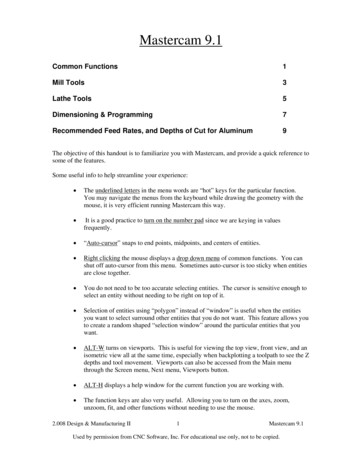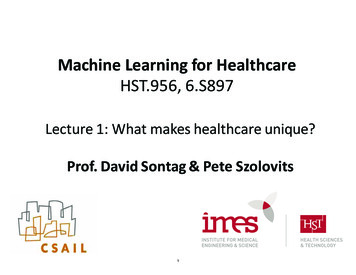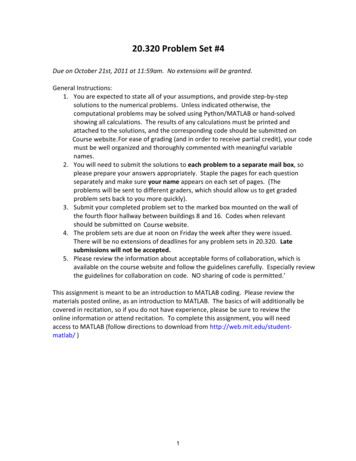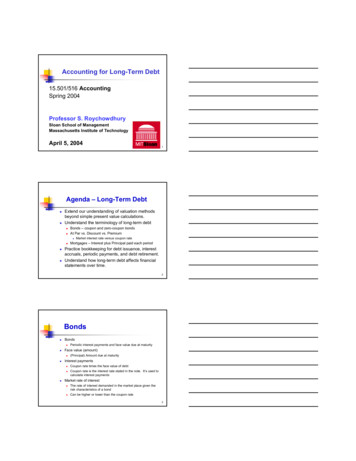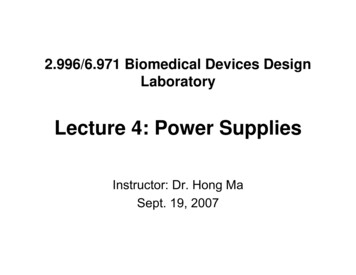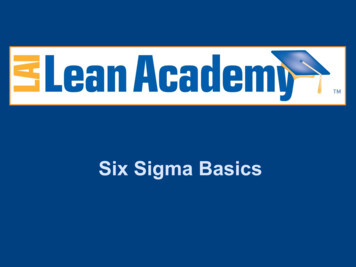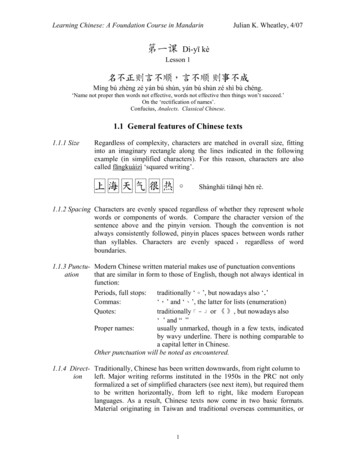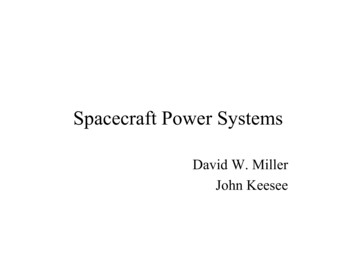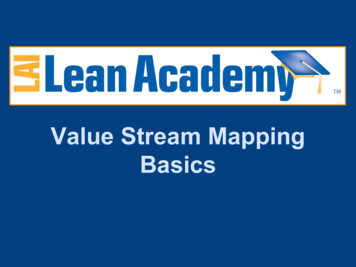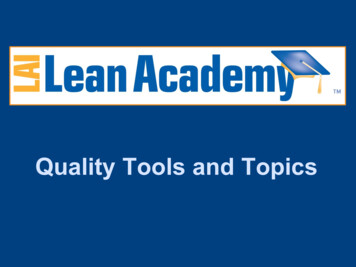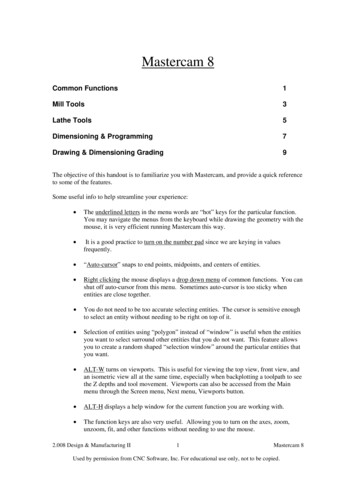
Transcription
Mastercam 8Common Functions1Mill Tools3Lathe Tools5Dimensioning & Programming7Drawing & Dimensioning Grading9The objective of this handout is to familiarize you with Mastercam, and provide a quick referenceto some of the features.Some useful info to help streamline your experience: The underlined letters in the menu words are “hot” keys for the particular function.You may navigate the menus from the keyboard while drawing the geometry with themouse, it is very efficient running Mastercam this way. It is a good practice to turn on the number pad since we are keying in valuesfrequently. “Auto-cursor” snaps to end points, midpoints, and centers of entities. Right clicking the mouse displays a drop down menu of common functions. You canshut off auto-cursor from this menu. Sometimes auto-cursor is too sticky whenentities are close together. You do not need to be too accurate selecting entities. The cursor is sensitive enoughto select an entity without needing to be right on top of it. Selection of entities using “polygon” instead of “window” is useful when the entitiesyou want to select surround other entities that you do not want. This feature allowsyou to create a random shaped “selection window” around the particular entities thatyou want. ALT-W turns on viewports. This is useful for viewing the top view, front view, andan isometric view all at the same time, especially when backplotting a toolpath to seethe Z depths and tool movement. Viewports can also be accessed from the Mainmenu through the Screen menu, Next menu, Viewports button. ALT-H displays a help window for the current function you are working with. The function keys are also very useful. Allowing you to turn on the axes, zoom,unzoom, fit, and other functions without needing to use the mouse.2.008 Design & Manufacturing II1Mastercam 8Used by permission from CNC Software, Inc. For educational use only, not to be copied.
Commonly used function keys:F1: ZOOMF2: UNZOOMF3: REPAINTF9: SHOW X0, Y0 AXESALT F1: FITALT F2: UNZOOM by .8ALT F3: CURSOR TRACKINGF10: KEY ASSIGNMENTS LISTThe button bar across the top has most of these functions.TrimmingAlways select the portion of the entity you want to keep. The portion of the entity on theother side of the intersecting entity will disappear, resulting in trimming the portion you click, tothe intersecting entity. Follow the prompts at the lower left of the screen.LevelMain and Visible are most commonly used. Creating your geometry on level 1, anddrafting on level 2 works well. You can then make your drafting invisible when you runtoolpaths.ColorThis displays the color pallet for changing the colors of entities. The system defaults togreen (#10) for geometry. It also uses certain colors for showing that you have selected an entity,or for showing a result of a transform. Toolpath feed moves are blue (#11). When you performtransform function, the system identifies the selected entities as a “group” with the color red (#12)and identifies the transformed entities as a “result” with the color purple (#13). Group and resultdesignations are saved with geometry. Rapid movements of toolpaths are yellow (#14). Aselected entity is white (#15).Geometry brought in from Pro Engineer, or Solidworks may be white, change it to greenso the color white can be used as intended. If you want to change the default color it is suggestedthat you use colors other than 10 - 15 to minimize confusion.Branch PointsBranch points are located where the endpoints of three or more entities meet. Branchpoints are not automatically created at intersections. You must break the entities to make thembranch points. To create a branch point, use the Modify, Trim, or Modify, Break functions.Drafting GlobalsUse this to alter the way dimensioning is displayed. To get to the screen, from the MainMenu go to Create, Drafting, Globals. It will display screens for altering drafting settings. SeeDimensioning, and Editing dimensions on page 7.2.008 Design & Manufacturing II2Mastercam 8Used by permission from CNC Software, Inc. For educational use only, not to be copied.
Mill ToolsTools Manager lists all the tools in the tool library, or in your current job. The tools inthe Trktools library are the available tools we have setup for the EZ-Trak mills. Clicking on thecolumn headings will sort the list. Generally you will only be accessing this list to get a tool touse.Double clicking on a tool will bring up a graphic display of the tool, showing its length,diameter, and clearance, along with the holder dimensions. Parameter screens allow the editingof how the tool is to be used, such as depths of cut and step-over amounts for roughing as well asspeed and feed for the tool to use. These are already setup to fairly good values to minimize toolbreakage. Please refrain from editing the tools; if you believe you may have altered one bymistake please let us know so we can refresh it.2.008 Design & Manufacturing II3Mastercam 8Used by permission from CNC Software, Inc. For educational use only, not to be copied.
Mill Job SetupIt is important that the toolpath configuration list has the boxes checked as they are in thisscreen shot. It is not necessary to fill out the X, Y, Z fields. Most important is that you do notwant to assign tool numbers sequentially. If they are assigned sequentially the machine will pickup the wrong tools. Open this window when you first start Mastercam Mill. From the MainMenu, Toolpaths, Job Setup.2.008 Design & Manufacturing II4Mastercam 8Used by permission from CNC Software, Inc. For educational use only, not to be copied.
Lathe ToolsLathe Tool Manager lists all the tools in the tool library, or in your current job, dependingon what screens you have opened you will get either one or the other. The tools in the Ltoolslibrary above, are the available tools we have in our machine. Hovering the mouse over a toolwill display a pop-up graphics view of the tool to aid in choosing the correct tool. Clicking on thecolumn headings will sort the list. Turning off the filter will show all the tools. Generally youwill only be accessing this list to select a tool to use.Highlighting a tool by clicking it once, then clicking OK, will select the tool for theoperation you have chained. Double clicking on a tool opens the parameters of the tool andallows editing. The right click menu allows you to display the tool by selecting Draw tool, soyou can see if it’s the one you want.Parameter screens for editing tools are not shown in this handout. They allow the editingof the tool’s characteristics, such as the geometry of the holder, the insert, the orientation of thetool to the machine, depths of cut and step-over amounts for roughing as well as speed and feedfor the tool to use. These have been tailored by the staff, and are setup to reasonable values tominimize tool breakage. Please refrain from editing the tools. If you believe you may havealtered one by mistake please let us know so we can refresh it.2.008 Design & Manufacturing II5Mastercam 8Used by permission from CNC Software, Inc. For educational use only, not to be copied.
Lathe Job SetupStock dimensions must be defined in your geometry for the system to function properlywithout collisions. This will be discussed in the lab. This screen is used to identify where thematerial is, for the system to avoid collisions during entry/exit moves, and positioning moves.Without the use of this screen unpredictable results may occur resulting in possible tool breakage,or damage to the part or the machine. It is important to note that the check box “Assign toolnumbers sequentially” should not be checked.2.008 Design & Manufacturing II6Mastercam 8Used by permission from CNC Software, Inc. For educational use only, not to be copied.
Dimensioning and ProgrammingDimensioningTo alter drafting settings start from the “MAIN MENU”, go to “Create”, “Drafting”, “Globals”. You canalso edit most elements when you’re in the middle of creating the drafting dimensions. In the process ofcreating drafting a menu of “hot” keys will appear across the top of the geometry screen enabling you toalter the way a dimension looks before you land it in a fixed position.Editing dimensionsGo to “Create”, “Drafting”, “Multi edit”. Select the dimension you want to move or edit, click “Done”.The Drafting Globals screen will appear. You don’t have to do anything with it just click “OK” to close it.Then select the dimension again that you want to alter, (just click it once), now it will move for you and themenu with the hot keys will be displayed so you can edit the elements before you click again to fix it in anew location.Saving filesYou must save your files with names that are 8 characters or less, and have the extension “.txt”. The EZTraks are DOS based and do not recognize files with long names, or other extensions. Change the defaultpath to your assigned lab section folder to save your work. Mastercam will default to C:\temp, it is cleanedout when you log off so save your docs to your folder when you begin a session, and save often.Changing the editorFrom the “MAIN MENU”, go to “File”, “Edit”, “Editor”, change to “MCEDIT” if you want to have theoption of changing incremental values to absolute. The default editor will work for normal editing.Incremental (G91) and Absolute (G90)If your geometry is such that it is easier for you to program using incremental values for some features, youmay do so. Enter a “G91” on the lines of code that are incremental values. Be careful to include a “G90”on the Z-axis moves. You always want to know where the Z-axis is in absolute values. Remember, “G91,and “G90” are in the same modal group and each one will remain in effect until the other is used.If you want to alter a string of incremental values to absolute, so you don’t have to worry about the modeyou’re in (G91, or G90), the “MCEDIT” editor has the function to alter the values.Altering incremental values to absolute values with the “MCEDIT” editor:1. Highlight the lines of code you want to alter. The highlighted lines must include the start point,and that must be in absolute values, and include both the X, and Y-axes. The start point will notbe altered, but all the values after the start point will be altered, and calculated using the start pointvalues.2. Select the “NC utils” menu in the editor window. Select “Incremental to Absolute”, a dialog boxwill open asking for the axes you wish to alter, select only X, and Y, you want Z to remainabsolute. You always want to know where Z is in absolute values.Z-zeroAlways set Z-zero at the top surface of the work-piece. This is the logical place for referencing the Z-axis.The industry standard is such that all Z depths are negative, and any Z positive values are usually in theclear so that you can rapid-position from feature to feature without worrying about running into the workpiece when you are in the positive region. Unfortunately the EZ-Trak machines have not followed the rulesof the industry for drilling.2.008 Design & Manufacturing II7Mastercam 8Used by permission from CNC Software, Inc. For educational use only, not to be copied.
DrillingDrilling depths are handled totally different than milling depths on the EZ-Trak machines.Drilling depths are taken as incremental positive values from the clearance plane, where as all millingdepths follow the industry rules and are absolute values and negative when the Z-axis zero is at the topsurface of the work-piece.On a “G81”, or “G83” block, you must include the X, and Y values of the hole position even if you havepositioned there from home. The block must also include a positive Z that is the sum of the depth you wantto drill plus the clearance plane (R) value, include the R value as well, and the feed rate for the plunge. Forexample: “G81G90X1.Y-.5Z.2R.1F5.” This will drill a hole -.1” deep.For peck drilling (G83), all the above applies but in addition, another Z must be included to state only thepeck amount itself. It is also positive and is an incremental value. The Z for the peck value must follow theZ depth value. For example: “G83G90X1.Y-.5Z.6Z.09R.1F5.” This will drill to a depth of -.5”, pullingout to the “R” level every time it drills .09” deeper until reaching the final depth. It is not necessary tomake sure that the peck amounts add up to the final depth. The drilling will only go to the final depth.TestingTesting your program with Reverse Post-processing and using Backplot.1. Save your handwritten program, make sure it is a “.txt” file. Leave it open and displayed so youmay edit it easily if there is something wrong.2. Save your Mastercam geometry file, do not change the filename extension leave it as “.MC8”.3. Then in Mastercam from the “MAIN MENU”, click “File”, “New”. Yes, you are sure you want toinitialize Mastercam.4. From the “MAIN MENU”, go to “NC utils”, “Post proc”, “Reverse”, go to where you saved your“.txt” program file and select it. Mastercam will create an “.NCI” (intermediate file) file to writeto, it will default to the name you named the “.txt” file, that’s OK. It will display the binary codefile it creates. This binary code file is what it will use to drive the Backplot display.5. Close the “.NCI” file, then go back to the “NC utils” menu and click, “Backplot”. In the lower leftof the screen it will show the “.NCI” filename it will read for the backplot. It should be displayingthe one Mastercam just created, if not, select the NCI file you want to read, by clicking “NCIname”.6. Then click on “Gview: T”, the lowest button on the menu and select “Isometric”, this will enableyou to view movement in all 3 axes.7. Then select Step. Each time you click “Step” you will see the movement the program isoutputting. Blue lines are feed movements. Yellow lines are rapid moves. If anything lookswrong you can edit the line of code that is causing the problem, and reverse post-process the fileagain.Distinguishing what is correctVertical lines going in the “down (Z negative)” direction must be blue signifying a feed movement. (Youdon’t want to rapid into the work!) Once you are in the work (Z negative area) all horizontal lines must alsobe blue (feeding). Vertical lines going up from a blue horizontal line should be yellow signifying a rapidmovement out of the work-piece. Once a yellow ‘up’ line appears it’s usually followed by another ‘rapid’move signifying a positioning move to another location. It would be expensive to waste time to position toa new location in a feed mode. Grading will take these issues into account. Moves to, or from machinehome are not displayed.Speeds and FeedsRecommended Speeds, feeds, and depths of cut for the available toolsAll spindle speeds should be 3000 RPM, except the 1.5” end mill, which should be run at 500 RPM for cutsdeeper than .050”. 1.5” end mill can be run at 2000 RPM for face milling, where the maximum depth ofcut would be only .010”-.015” deep.2.008 Design & Manufacturing II8Mastercam 8Used by permission from CNC Software, Inc. For educational use only, not to be copied.
Recommended Feed Rates for machining Aluminum1/16” end mill:1/8” end mill:¼” end mill:3/8” end mill:½” end mill:1.5” end mill:All taper mills:#1Center drill:#4 Center drill:plunge at 2”/min., feed at 4”/minplunge at 3”/min., feed at 5”/minplunge at 5”/min., feed at 10”/minplunge at 5”/min., feed at 15”/minplunge at 5”/min., feed at 15”/minplunge at 5”/min., feed at 20”/minplunge at 5”/min., feed at 10”/minplunge at 5”/min.plunge at 10”/min.Depths of cut for AluminumFor the 1/16”-1/2” end mills: 1/3 the end mill diameter per level.Maximum final depth for the 1/16”-1/2” end mills is 3X their diameters.For the taper mills: 1/16” per level, except the engraving tool.For the 1.5” end mill: .100” per level.Engraving tool: .010” per level to a maximum depth of .030” (the tip angle is 60 degrees).For fine engraving: .005”-.007” max depth. Produce a flat uniform surface by face milling the surface firstusing the 1.5” end mill.Drawing & Dimensioning GradingGuideline for grading Paperweight drawings, and drawings produced in the Yo-yo labs.Dimensioning features where points will be taken. First occurrence basis per reportbased on a perfect score of 10.0.1 Point issues:1. Line thickness: dimensions, center lines, phantom lines, leaders, and arrows, to be finerthan drawing lines2. Missing center lines3. Missing center points4. Missing arrows, unless ordinate dimensioning is used5. Both arrows point same way0.2 Point issues:6. Showing tangencies.7. Arrows pointing to radii at quadrants, or arrows do not point to or go through the centerof the radius.8. Overlapping dimensions, arrows, or leaders. General clutter causing difficulty readingprint.9. Not using an extra print when necessary to minimize clutter, or to clarify a detail.10. Double dimensioning11. Wrong way to show dimension, such as showing a diameter as a radius, or visa versa12. Having dimensions in parenthesis when you do not intend the dimension to be shown as areference dimension2.008 Design & Manufacturing II9Mastercam 8Used by permission from CNC Software, Inc. For educational use only, not to be copied.
13. Missing lines14. Dimensions within a view15. If using multiple sheets, not specifying there are other sheets, i.e. sheet 1 of 2, sheet 2 of2, and so on16. Mixed, or wrong Angle Projections. In America we sweep (3rd angle projections), inEurope they roll (1st angle projections).17. Cross-sections not oriented, or displayed properly.18. Different size fonts.19. Dimensioning to tangencies.20. Extra dimensions that are not necessary.21. Wrong values.22. Wrong line type.0.5 Point issues:23. Missing dimensions24. Not showing whole part, except for the Lab I deliverable where the top view can be aseparate drawing from the profile view. The Lab III requirement is to combine the views.25. Not specifying engraving depth and tool to use as a note.26. Design shows major geometry features that cannot be machined with tooling provided,such as groove depths designed deeper than the length of cut for the tool.27. Missing features for snap fit; draft where there should be straight wall engagement.28. Dimensions upside-down.1.0 Point issues29. Conflicting dimensions between mating core and cavity molds; height of core exceedsdepth of cavity.Part Program GradingGuideline for grading Paperweight, and Yo-yo lab programs.Programming features where points will be taken. First occurrence basis perprogram based on a perfect score of 10.0.1 Point issues:1. Missing decimal points.2. Lowercase letters.0.2 Point issues:1.2.3.4.5.6.7.8.Facing with wrong tool.Missing a G0 Z.1 at tool start-up.Missing an X, and Y movement at tool start-up.Rapid Z move on same block as X, and Y move.G1, and G2 on same block.2 feeds on same block.Tool pick-up and X, Y move on same block.Turning backwards, (from chuck towards turret).2.008 Design & Manufacturing II10Mastercam 8Used by permission from CNC Software, Inc. For educational use only, not to be copied.
9.10.11.12.Using a trepanning tool where a larger tool would be more suitable for the operation.Finish cuts at roughing feed rates.Rapid Z move to .1 before positioning to location in the X, and Y axes at tool start-up.Using wrong tool for trepanning.0.5 Point issues:13. Plunging too deep for selected tool.14. Missing a Z retract before positioning to a new location.15. Returning to a G1 after being in a G2, or G3 move when the intent was to go back tolinear motion, from circular motion.16. Turning OD to Z-.517. Missing workshift designation, (G55, G56, G57).2.008 Design & Manufacturing II11Mastercam 8Used by permission from CNC Software, Inc. For educational use only, not to be copied.
Mastercam 8 Common Functions 1 Mill Tools 3 Lathe Tools 5 Dimensioning & Programming 7 Drawing & Dimensioning Grading 9 The objective of this handout is to familiarize you with Mastercam, and provide a quick reference to some of the featu
